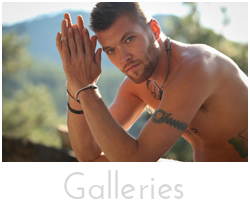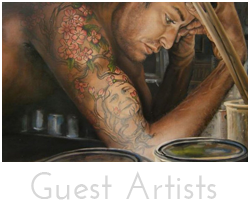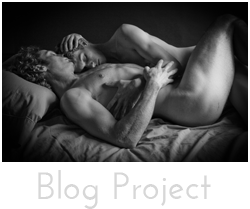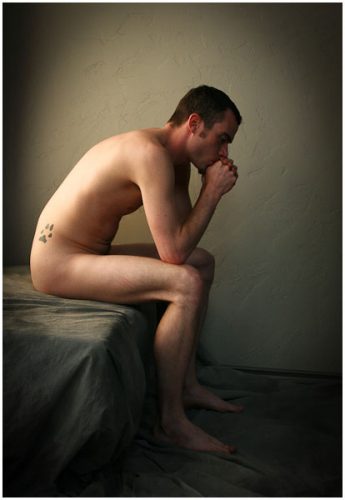 We have finally got the news that Man Art will be removed from the Internet within the next couple of days. Today I am filled with joy to look back and read all the comments on the work I submitted less than a year ago. I am eternally thankful for the amazing people I have met on this site and the encouragement you have given me to grow. Thanks for seeing things in me and my imagery that I couldn’t, and for helping me to recognize it. I wanted to reprint my first blog I posted and on Man Art and some of the response I got to it. Thanks to all for believing in me and giving me the courage to create even in a remote place like Montana.
We have finally got the news that Man Art will be removed from the Internet within the next couple of days. Today I am filled with joy to look back and read all the comments on the work I submitted less than a year ago. I am eternally thankful for the amazing people I have met on this site and the encouragement you have given me to grow. Thanks for seeing things in me and my imagery that I couldn’t, and for helping me to recognize it. I wanted to reprint my first blog I posted and on Man Art and some of the response I got to it. Thanks to all for believing in me and giving me the courage to create even in a remote place like Montana.
New Direction
* Posted by Terry J Cyr on May 20, 2010 at 8:36am
I moved in a new direction today. After months of frustration and now not getting the job at the University I am at wits end. Frustrated. It feels like the only thing I am good at is photographing men naked. I love this and feel I have amassed a huge collection of images over the year; that no one ever sees or appreciates. My new approach today was to begin putting myself out there and see if I can connect with other artists like myself and see if I can feel any kind of sense of place in the world I love best. Montana is not the hotbed of male erotic art. It’s a constant frustration to find people who will ever work with me and allow me to photograph them. I am desperate for some new connection.
Bryan Spellman: I’m glad to have led you to Man Art. It’s a great place with some wonderful men–most of whom seem to be far, far from us. But your own work is strong and I’m so glad you’re sharing it. You deserve recognition for all you’ve accomplished. Missoula is a frustrating place. I can’t even find guys willing to model for me in their clothing–let alone nude. Hang in there my friend, and let’s do some art together.
Bruce Miller: I hope you’ll find that here. I have! I also like your work and I think you’ll be a good match. Welcome…
John Douglas: I hope this site provides some inspiration and support – and yeah the search for good models, even bad models can be frustrating at times – you start to see why many artists when they find a good model keep using that one. Best of luck, and I hope this is the beginning of a great new period in your art.
“The time has come
To go our separate ways
And it’s alright if you wanna cry
Though I know we’ll meet again someday
It’s never easy to say goodbye”
Lyrics from IT’S NEVER EASY TO SAY GOODBYE by Kenny Chesney. Country Music just seem to be the right tone for today’s topic.

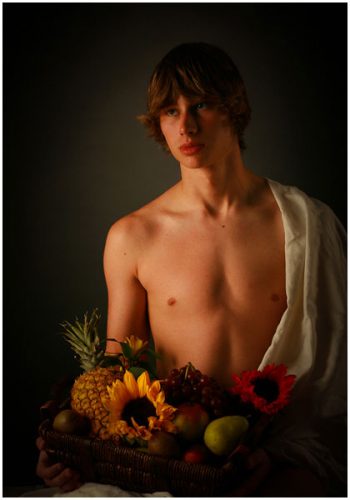 I am not exactly sure of my strong connection to Caravaggio. These is a deep spirituality that exists in the images that has a strong pull on my subconscious and create a sort of cathartic effect on me emotionally. It’s not merely about the lighting, which is brilliant, but it is about humanity revealed on the canvas. Many of the images draw on religious stories, but instead of elevating them to an ethereal level he has imbued them with an earthly reality. JUDITH BEHEADING HOLOFERNES 1598, MARTERDOME OF SAINT MATTHEW 1599 The images I am drawn to are of the male nudes which have such a sensual quality to them of SAINT JOHN THE BAPTIST 1602, JOHN THE BAPTIST 1605. Caravaggio always painted from reality, which was revolutionary at the time. He used real subjects that he would pose and stage and paint. A painting would have taken weeks to produce and they did not have the means of modern light to maintain such consistency. The artist studios of this area where so elaborate and much of what was seen had to be illuminated by candle. I have seen images of massive candelabras with a hundred candles on them that were attached to a pulley system and become fully adjustable to create a constant source. They would also use light from a window at specific times of the day, or a series of mirrors that could reflect the light on the subject and be adjusted as the light changed through out the day. The depth and tone created by actual light is stunning and adds such a multi-dimensional quality to the subject. But I think what is most remarkable about Caravaggio’s images is that he gives such inner life to his subjects. It’s almost like he reveals their souls though expression, position and of course light and color. I am entranced to look into these visions.
I am not exactly sure of my strong connection to Caravaggio. These is a deep spirituality that exists in the images that has a strong pull on my subconscious and create a sort of cathartic effect on me emotionally. It’s not merely about the lighting, which is brilliant, but it is about humanity revealed on the canvas. Many of the images draw on religious stories, but instead of elevating them to an ethereal level he has imbued them with an earthly reality. JUDITH BEHEADING HOLOFERNES 1598, MARTERDOME OF SAINT MATTHEW 1599 The images I am drawn to are of the male nudes which have such a sensual quality to them of SAINT JOHN THE BAPTIST 1602, JOHN THE BAPTIST 1605. Caravaggio always painted from reality, which was revolutionary at the time. He used real subjects that he would pose and stage and paint. A painting would have taken weeks to produce and they did not have the means of modern light to maintain such consistency. The artist studios of this area where so elaborate and much of what was seen had to be illuminated by candle. I have seen images of massive candelabras with a hundred candles on them that were attached to a pulley system and become fully adjustable to create a constant source. They would also use light from a window at specific times of the day, or a series of mirrors that could reflect the light on the subject and be adjusted as the light changed through out the day. The depth and tone created by actual light is stunning and adds such a multi-dimensional quality to the subject. But I think what is most remarkable about Caravaggio’s images is that he gives such inner life to his subjects. It’s almost like he reveals their souls though expression, position and of course light and color. I am entranced to look into these visions.
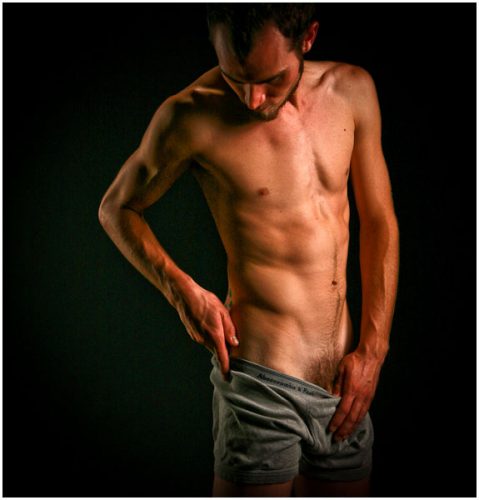 I woke up excited this morning. I have Travis Elliot one of my favorite all time subjects coming into the studio to work on some new images based on the lighting styles of the Italian painter Caravaggio.
I woke up excited this morning. I have Travis Elliot one of my favorite all time subjects coming into the studio to work on some new images based on the lighting styles of the Italian painter Caravaggio.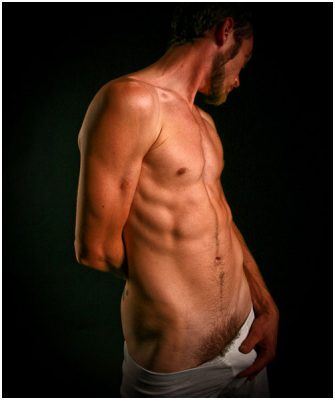 But what really excites me about working with Travis today is that we are going to explore the lighting and images of the painter Caravaggio. I have been doing a research project on the painter for some time and have been dabbling in the style, but today I really get to explore it. Tomorrow I will talk about the process of pursuing Caravaggio, which was going to become the subject today, but some insight into my working relationship with Travis seemed more insightful and extends beyond just a mention. I now use the lower image as the avatar that becomes the symbol of my nude imagery. This was a hallmark moment in my work, I had suddenly transcended beyond Travis and myself and elevated my images to a new level of art.
But what really excites me about working with Travis today is that we are going to explore the lighting and images of the painter Caravaggio. I have been doing a research project on the painter for some time and have been dabbling in the style, but today I really get to explore it. Tomorrow I will talk about the process of pursuing Caravaggio, which was going to become the subject today, but some insight into my working relationship with Travis seemed more insightful and extends beyond just a mention. I now use the lower image as the avatar that becomes the symbol of my nude imagery. This was a hallmark moment in my work, I had suddenly transcended beyond Travis and myself and elevated my images to a new level of art.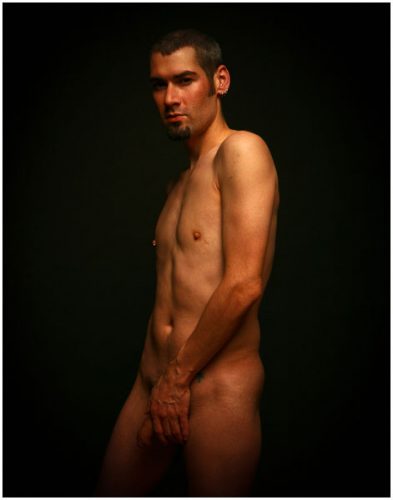
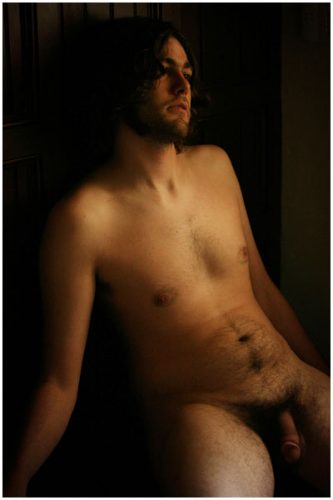 I am deeply drawn to the strong contrast between light and dark. This style is defined by a term called chiaroscuro. Webster defines Chiaroscuro as the “interplay or contrast of dissimilar qualities (as of mood or character)”. This definition best exemplifies me as a person, though the term is generally not associated with psychology it is a perfect description of my personality. Wikipedia says it is an Italian word for light-dark and in art is characterized by strong contrasts between light and dark, usually bold contrasts affecting a whole composition. To me this is the edge where beauty dwells. It is the edge I am most drawn to, feel safe, and most at home. It seems that everyone I meet is in conflict with something in their lives. Either a psycho/social disorder they can name and treat or a secret they keep buried deep within. My process of photography is to discover that edge, to explore their insecurity and bring it to light in images that give them a different perspective. We live in a modern world where we are told the norm is physical perfection: sculpted, toned, and enhanced with product. None of us are truly this way; the reality is that we are just average people making an average go of our lives. We become so clouded in our perceptions of what we think we want to be that we refuse to see what is truly remarkable within ourselves. I face and resist these issues myself and know they have changed as I have changed, my current insecurities facing my own process of aging. This is what my photography actually becomes about. It’s the search for identity within my process. I have always been drawn to this contrast within myself and now I externally manifest it through the images I create. I see myself emerging from light into darkness. I find comfort in shadows and therefore paint with light what I feel within. Desire is a strong motivation. I was romantic at heart, sensual, and passionate on such a physical level in my youth. But as I age these qualities fade, an erosion of time. It is through my images I bring them back to existence, revisit my youth, and seek beauty. It is the experience of my life and pleasure that I bring to others, who are lost in their own insecurities, and illuminate something extraordinary about them. I use classical art as my inspiration. The painter I feel the greatest kinship to is
I am deeply drawn to the strong contrast between light and dark. This style is defined by a term called chiaroscuro. Webster defines Chiaroscuro as the “interplay or contrast of dissimilar qualities (as of mood or character)”. This definition best exemplifies me as a person, though the term is generally not associated with psychology it is a perfect description of my personality. Wikipedia says it is an Italian word for light-dark and in art is characterized by strong contrasts between light and dark, usually bold contrasts affecting a whole composition. To me this is the edge where beauty dwells. It is the edge I am most drawn to, feel safe, and most at home. It seems that everyone I meet is in conflict with something in their lives. Either a psycho/social disorder they can name and treat or a secret they keep buried deep within. My process of photography is to discover that edge, to explore their insecurity and bring it to light in images that give them a different perspective. We live in a modern world where we are told the norm is physical perfection: sculpted, toned, and enhanced with product. None of us are truly this way; the reality is that we are just average people making an average go of our lives. We become so clouded in our perceptions of what we think we want to be that we refuse to see what is truly remarkable within ourselves. I face and resist these issues myself and know they have changed as I have changed, my current insecurities facing my own process of aging. This is what my photography actually becomes about. It’s the search for identity within my process. I have always been drawn to this contrast within myself and now I externally manifest it through the images I create. I see myself emerging from light into darkness. I find comfort in shadows and therefore paint with light what I feel within. Desire is a strong motivation. I was romantic at heart, sensual, and passionate on such a physical level in my youth. But as I age these qualities fade, an erosion of time. It is through my images I bring them back to existence, revisit my youth, and seek beauty. It is the experience of my life and pleasure that I bring to others, who are lost in their own insecurities, and illuminate something extraordinary about them. I use classical art as my inspiration. The painter I feel the greatest kinship to is 